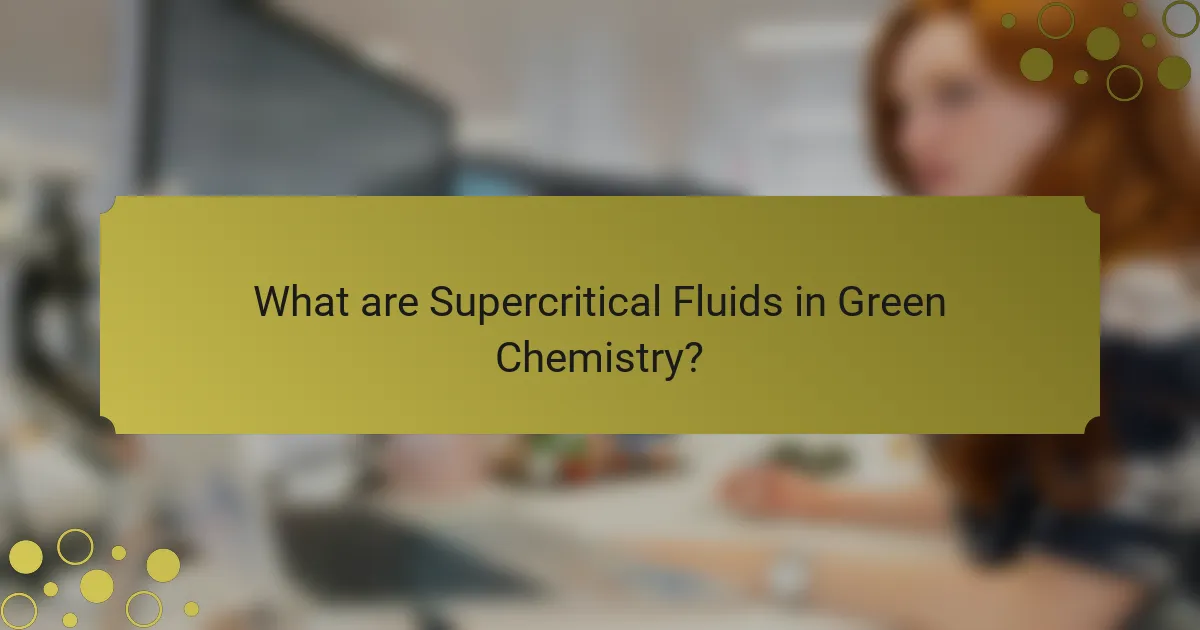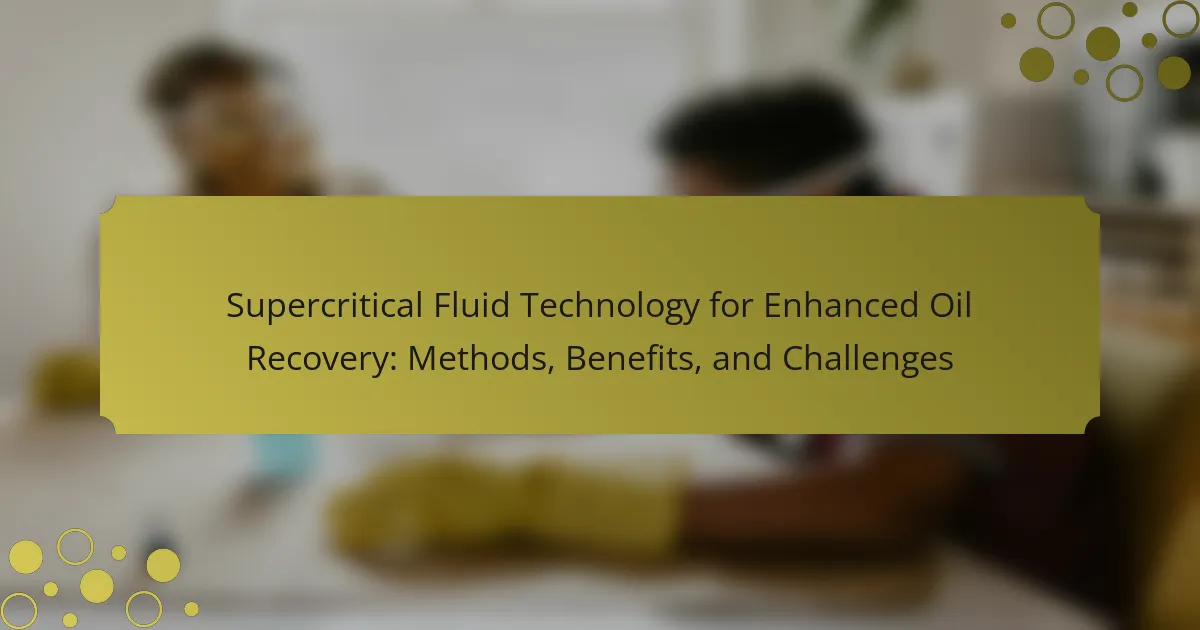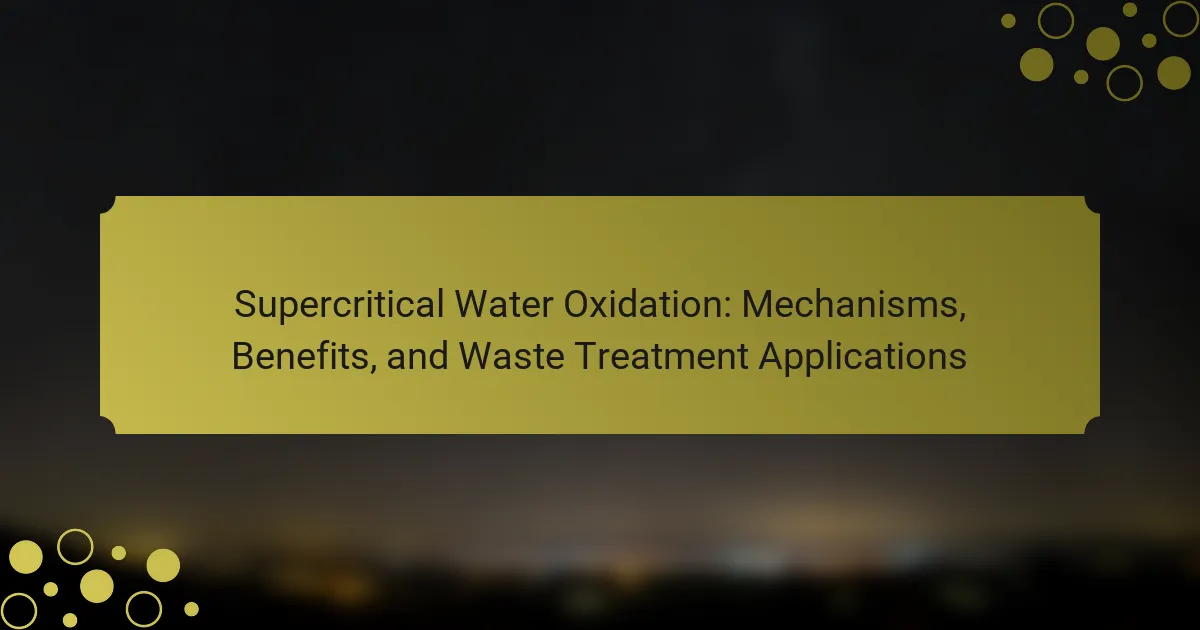Supercritical fluids are substances that exist at temperatures and pressures above their critical points, exhibiting unique properties that make them valuable in green chemistry. This article explores the applications, benefits, and innovations of supercritical fluids, particularly supercritical carbon dioxide, which serves as a non-toxic and environmentally friendly solvent. Key applications include extraction processes in the food and pharmaceutical industries, drug formulation, and cleaning applications. The use of supercritical fluids enhances reaction efficiency, reduces waste, and supports the development of new materials, thereby promoting sustainable practices in chemistry.

What are Supercritical Fluids in Green Chemistry?
Supercritical fluids are substances at a temperature and pressure above their critical point, exhibiting unique properties. In green chemistry, they are used as solvents to replace hazardous organic solvents. Supercritical carbon dioxide is the most common example. It has low toxicity and is environmentally friendly. These fluids can dissolve materials like gases and liquids, enhancing extraction processes. They also facilitate reactions with higher efficiency and selectivity. Studies show that using supercritical fluids can reduce waste and energy consumption in chemical processes. This makes them a valuable tool in sustainable chemistry.
How do supercritical fluids differ from traditional solvents?
Supercritical fluids differ from traditional solvents primarily in their unique state of matter. Supercritical fluids exist at a temperature and pressure above their critical point, combining properties of both liquids and gases. This state allows for enhanced solvation capabilities compared to traditional solvents. For instance, supercritical carbon dioxide can dissolve nonpolar compounds effectively, which traditional solvents may struggle with. Additionally, supercritical fluids have lower viscosity and higher diffusivity, enabling faster extraction and reaction rates. These characteristics make them more efficient for applications in green chemistry, as they often reduce the need for hazardous organic solvents. Studies have shown that using supercritical fluids can lead to lower energy consumption and less environmental impact in chemical processes.
What properties make supercritical fluids unique?
Supercritical fluids possess unique properties that differentiate them from gases and liquids. They exhibit a combination of gas-like diffusivity and liquid-like density. This allows for enhanced solvation capabilities, enabling them to dissolve a wide range of substances. Supercritical fluids also have tunable properties, meaning their density and solvent power can be adjusted by changing temperature and pressure. This versatility makes them effective in various applications, such as extraction and reaction processes. For instance, supercritical carbon dioxide is commonly used in extracting essential oils due to its efficiency and low toxicity. Their ability to penetrate porous materials further enhances their utility in green chemistry applications.
Why are supercritical fluids considered environmentally friendly?
Supercritical fluids are considered environmentally friendly because they reduce the need for harmful solvents. They can dissolve a wide range of substances without the toxicity associated with traditional organic solvents. Supercritical carbon dioxide, for instance, is non-toxic and can be sourced from renewable resources. This fluid can replace conventional solvents in extractions and reactions, minimizing hazardous waste. Additionally, supercritical processes often operate at lower temperatures and pressures, leading to energy savings. Studies show that using supercritical fluids can decrease volatile organic compound emissions significantly. Overall, their use aligns with green chemistry principles by enhancing safety and sustainability.
What role do supercritical fluids play in green chemistry?
Supercritical fluids serve as efficient solvents in green chemistry. They enable environmentally friendly extraction processes. Supercritical carbon dioxide is a common example. It replaces hazardous organic solvents, reducing pollution. This method minimizes waste and energy consumption. Supercritical fluids also enhance reaction rates and selectivity. Studies show they can improve yield in chemical reactions. Their tunable properties allow for optimized conditions in various applications.
How do they contribute to sustainable practices?
Supercritical fluids contribute to sustainable practices by minimizing hazardous waste and reducing energy consumption. They provide an efficient alternative to traditional solvents, which are often toxic and environmentally harmful. Supercritical fluids can dissolve a wide range of substances, allowing for cleaner extraction and processing methods. This results in lower emissions and less reliance on volatile organic compounds. According to research, using supercritical carbon dioxide can decrease energy use by up to 90% compared to conventional methods. Additionally, these fluids can be recycled and reused, further enhancing their sustainability profile.
What are the primary applications of supercritical fluids in green chemistry?
Supercritical fluids are primarily used in green chemistry for extraction, reaction media, and cleaning processes. They efficiently extract bioactive compounds from plants, enhancing yield while minimizing solvents. Supercritical carbon dioxide is a common choice due to its low toxicity and environmental impact. In reactions, supercritical fluids provide unique solvation properties, promoting faster and more selective reactions. They also serve as cleaning agents, replacing harmful organic solvents in industrial applications. These processes align with green chemistry principles by reducing waste and energy consumption. Research shows that supercritical fluid extraction can yield higher purity products compared to traditional methods.

What are the key applications of supercritical fluids?
Supercritical fluids have several key applications in various fields. They are widely used in extraction processes, such as decaffeination of coffee and extraction of essential oils. This method utilizes supercritical carbon dioxide, which is an effective solvent that is non-toxic and environmentally friendly.
In the pharmaceutical industry, supercritical fluids assist in drug formulation and delivery. They enable the creation of nanoparticles that enhance the solubility of poorly soluble drugs. Furthermore, supercritical fluids are employed in chemical reactions, acting as solvents that can improve reaction rates and selectivity.
Additionally, supercritical fluids are used in cleaning applications, particularly in the removal of contaminants from surfaces and materials. This method offers a non-toxic alternative to traditional solvents. In materials science, they contribute to the development of new materials with unique properties through supercritical drying processes.
These applications illustrate the versatility and effectiveness of supercritical fluids in promoting green chemistry practices.
How are supercritical fluids used in extraction processes?
Supercritical fluids are used in extraction processes to efficiently separate desired compounds from mixtures. They possess unique properties, allowing them to act as both gas and liquid. This dual behavior enhances solubility and mass transfer during extraction. Common supercritical fluids include carbon dioxide, which is non-toxic and environmentally friendly.
In extraction, supercritical CO2 can dissolve various organic compounds, including essential oils and flavorings. The process typically occurs under controlled temperature and pressure, optimizing extraction yields. Studies show that supercritical fluid extraction can reduce solvent usage by up to 90% compared to traditional methods. This makes it a sustainable alternative in industries like pharmaceuticals and food processing.
What are the advantages of using supercritical CO2 for extraction?
Supercritical CO2 extraction offers several advantages. It is a non-toxic and environmentally friendly solvent. This method does not leave harmful residues in the final product. Supercritical CO2 can selectively extract specific compounds. This selectivity leads to higher purity and quality of the extracts. The process operates at relatively low temperatures. This helps preserve sensitive compounds, such as essential oils. Additionally, supercritical CO2 is cost-effective in the long run. It allows for the recycling of the solvent, reducing operational costs. These benefits make supercritical CO2 extraction a preferred choice in various industries, including food and pharmaceuticals.
In which industries is supercritical fluid extraction most prevalent?
Supercritical fluid extraction is most prevalent in the food and beverage, pharmaceutical, and cosmetic industries. In the food industry, it is used for extracting flavors, essential oils, and antioxidants. The pharmaceutical sector utilizes this method for isolating active compounds from natural sources. Cosmetics companies employ supercritical fluid extraction to derive plant extracts for skincare products. This extraction method is favored due to its efficiency and ability to preserve sensitive compounds. Additionally, the environmental benefits of reduced solvent use enhance its appeal across these industries.
What are the applications of supercritical fluids in chemical reactions?
Supercritical fluids are used in various chemical reactions for their unique properties. They can enhance reaction rates and selectivity. Supercritical carbon dioxide is frequently employed in extraction processes. It effectively extracts essential oils and flavors from natural products. This method is environmentally friendly compared to traditional solvents. Supercritical fluids also facilitate reactions in catalysis. They can act as both solvent and reactant in certain reactions. This dual role can lead to more efficient processes. Moreover, supercritical fluids are utilized in polymerization reactions. They help in creating materials with specific properties.
How do supercritical fluids enhance reaction rates?
Supercritical fluids enhance reaction rates by providing unique solvent properties. These fluids exhibit both gas-like and liquid-like characteristics. This dual nature increases mass transfer efficiency. Enhanced mass transfer allows reactants to interact more readily. Supercritical fluids also offer higher solubility for reactants. Increased solubility leads to a greater concentration of reactants in the reaction medium. Additionally, supercritical fluids can facilitate better heat transfer. Improved heat transfer helps maintain optimal reaction temperatures. Studies show that reactions in supercritical fluids can occur up to ten times faster than in traditional solvents.
What types of reactions benefit from supercritical fluid usage?
Supercritical fluid usage benefits various types of reactions, particularly extraction, chemical synthesis, and catalysis. In extraction, supercritical fluids can efficiently remove compounds from matrices, enhancing yield and purity. For chemical synthesis, supercritical fluids provide a medium that can alter reaction rates and selectivity. Catalysis reactions benefit from supercritical fluids by improving mass transfer and reducing reaction times. These advantages lead to greener processes with lower environmental impact. Studies show that supercritical carbon dioxide is commonly used for these applications due to its non-toxic nature and effective solvent properties.

What are the benefits and innovations associated with supercritical fluids?
Supercritical fluids offer numerous benefits and innovations in various applications. They act as efficient solvents, enhancing extraction processes in food and pharmaceuticals. Supercritical CO2, for example, is non-toxic and environmentally friendly. It can replace organic solvents, reducing hazardous waste. Innovations include using supercritical fluids for material processing and nanoparticle synthesis. These methods allow for precise control over particle size and morphology. Additionally, supercritical fluids enable improved reaction conditions for chemical synthesis. This leads to higher yields and shorter reaction times. Overall, the advantages of supercritical fluids significantly contribute to sustainable practices in green chemistry.
What economic advantages do supercritical fluids provide?
Supercritical fluids offer significant economic advantages in various industries. They enable reduced energy consumption compared to traditional solvents. This efficiency leads to lower operational costs. Additionally, supercritical fluids can enhance extraction yields. Higher yields result in more product from the same raw materials. They also minimize the need for hazardous solvents. This reduces waste disposal costs and regulatory burdens. Furthermore, supercritical fluid processes can often be performed at lower temperatures. This can extend the lifespan of equipment and reduce maintenance costs. Overall, these factors contribute to improved profitability in processes utilizing supercritical fluids.
How do they reduce costs in manufacturing processes?
They reduce costs in manufacturing processes by utilizing supercritical fluids. Supercritical fluids can replace traditional solvents, leading to lower material costs. They also enhance extraction efficiency, reducing the amount of raw materials needed. This method minimizes waste generation, which lowers disposal costs. Additionally, supercritical fluid processes often require less energy compared to conventional methods. Research indicates that using supercritical carbon dioxide can reduce energy consumption by up to 50%. These factors collectively contribute to significant cost savings in manufacturing.
What impact do they have on product quality?
Supercritical fluids significantly enhance product quality in green chemistry applications. They provide precise control over extraction processes. This leads to higher purity levels in the final products. Supercritical fluids also minimize the use of harmful solvents. As a result, they reduce contamination risks. Studies show that products processed with supercritical fluids often exhibit better stability. For instance, essential oils extracted using supercritical CO2 retain more of their desirable compounds. This demonstrates the positive impact on product quality.
What recent innovations have emerged in the field of supercritical fluids?
Recent innovations in the field of supercritical fluids include advancements in extraction techniques and applications in pharmaceuticals. Researchers have developed more efficient supercritical CO2 extraction methods. These methods enhance the yield and purity of bioactive compounds. Innovations also include the use of supercritical fluids in the synthesis of nanoparticles. This approach allows for better control over particle size and morphology. Additionally, supercritical fluids are being explored for carbon capture and storage technologies. These applications contribute to reducing greenhouse gas emissions. Recent studies have shown that supercritical fluid processing can minimize solvent waste. This aligns with the principles of green chemistry by promoting sustainability.
How are researchers improving the efficiency of supercritical fluid processes?
Researchers are improving the efficiency of supercritical fluid processes by optimizing operating conditions and enhancing the design of equipment. They are adjusting parameters like temperature and pressure to maximize solubility and extraction rates. Advanced techniques such as ultrasound and microwave assistance are being integrated to facilitate faster extraction. Additionally, researchers are developing new supercritical fluid solvents that offer better performance and selectivity. Studies show that these innovations can significantly reduce processing times and energy consumption. For example, a study published in the Journal of Supercritical Fluids demonstrated a 30% increase in extraction efficiency using optimized parameters. This approach not only enhances yield but also supports sustainable practices in green chemistry.
What future trends are expected in supercritical fluid technology?
Future trends in supercritical fluid technology include increased applications in pharmaceuticals and food processing. Enhanced extraction methods using supercritical fluids are gaining attention for their efficiency and environmental benefits. The integration of supercritical fluids with nanotechnology is expected to improve material properties and performance. Research is focusing on optimizing supercritical fluid parameters for specific applications. Additionally, advancements in equipment design are anticipated to reduce operational costs. Regulatory support for green technologies will likely drive further adoption of supercritical fluid processes. These trends align with the growing demand for sustainable and eco-friendly solutions across various industries.
What best practices should be followed when utilizing supercritical fluids?
Best practices for utilizing supercritical fluids include ensuring proper temperature and pressure control. Maintaining optimal conditions enhances extraction efficiency and product quality. Regularly calibrating equipment prevents deviations that could affect results. It is crucial to select appropriate solvents for specific applications. Compatibility of the supercritical fluid with the target compounds is essential. Safety measures must be prioritized to handle high-pressure systems effectively. Conducting thorough risk assessments minimizes potential hazards. Finally, documenting procedures and outcomes aids in process optimization and reproducibility.
Supercritical fluids, particularly supercritical carbon dioxide, are integral to green chemistry due to their unique properties that enhance solvent capabilities while minimizing environmental impact. This article examines the applications of supercritical fluids in extraction processes, chemical reactions, and cleaning methods, emphasizing their role in reducing hazardous waste and energy consumption. Key benefits include improved product quality, cost-effectiveness, and innovations in extraction techniques and nanoparticle synthesis. Additionally, the article outlines best practices for utilizing supercritical fluids effectively in various industries, highlighting their contribution to sustainable and eco-friendly practices in chemistry.



